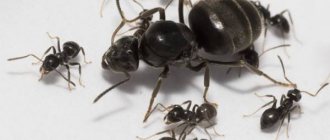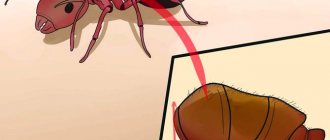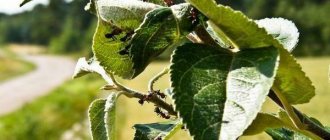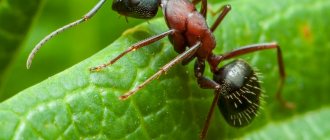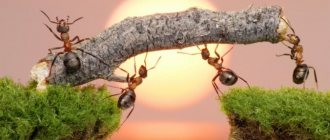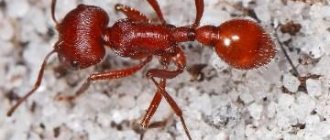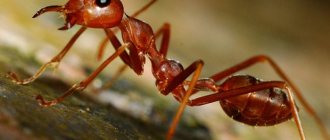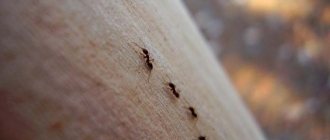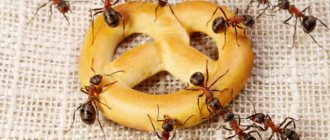Everyone has known ants since childhood. These creatures are characterized by labor-intensive abilities, thanks to which they carry objects many times the weight of their own body.
Also, many people know about the omnivorous nature of individuals living in natural conditions (forests, fields, vegetable gardens), as well as parasites that settle in human homes. Household pests are especially adapted to different types of food, making them quite difficult to eliminate.
Even if the apartment is kept perfectly clean, some housewives may find these insects in their kitchen and other rooms of the apartment. To understand the essence of behavior and survival of ants in different environmental conditions, you should understand what they prefer to eat in nature and at home.
Food distribution
The larvae get animal proteins. These are zoological remains, insect eggs. Ants bring gelatin, leftover scrambled eggs and dairy dishes from the house. Larvae require proteins for growth and development.
Adults consume carbohydrates. These are easily digestible by the body, seeds, nuts, flower nectar and tree sap, pulp of fruits and plant roots. Insects take honey, sugar, and jam out of a person’s home.
Each type of ant produces a specific food
- Stray ants and cerapachis ants eat only insects and their larvae.
- The ants feed the queen with crushed food, which they chew themselves. She eats this dessert.
- Some types of insects consume honeydew and honeydew. This dew forms on tree leaves after temperature changes. Honeydew is the name given to the sugary secretions of aphids and some other insects.
Drop the aphids - Red forest ants feed on honeydew. It makes up more than half of their diet. Therefore, they often protect and protect aphids.
- Carpenter ants extract carbohydrates from gum, that is, from tree resin. It appears when tree bark is damaged. However, they will not refuse honeydew, because one gum is not enough for them.
Reaper ant
The food of harvester ants is dry plant seeds .
This is a solid food, but it contains carbohydrates. Slaves of this type of insect, in addition to guarding the anthill, are required to crush hard seeds with strong jaws until a soft paste is formed. It is then eaten by other insects that occupy a higher status.
Ants in the garden: benefits and harm, methods of destruction
Why shouldn’t you rush to get rid of ants that have settled in your garden or vegetable garden? This is due to the fact that they are capable of providing benefits, namely eliminating pests and improving soil quality. At the same time, they cause a lot of harm:
- promote the spread of aphids;
- eat plantings;
- destroy flowering plants;
- destroy trees, lawns and flower beds;
- increase soil acidity;
- in case of unfavorable weather conditions, they move into the home;
- attack people and animals.
Fighting ants brings only temporary results, because their populations are huge and they are actively reproducing. The most effective products for killing these pests are those containing diazinon and chlorpyrifos. Ants in a summer cottage or in a vegetable garden can be exterminated using such popular preparations among gardeners and gardeners as “Absolute”, “Great Warrior”, “Aardeater”, “Thunder”, “Medvetox”. To protect trees from ants, trapping belts are used.
Ant feeding frequency
Foraging ants
Insects feed more than once a day. Foraging ants do not miss the opportunity to have lunch along the way. Insects remaining at home also feed on stored supplies.
In addition to the owners themselves, other insects live in the anthill, such as beetles, caterpillars, moths and their larvae. The owners do not drive them away; they even allocate their eggs to them. In return, they feed on their syrup. To do this, you need to touch the tenant and he will release a little tasty syrup.
Recipe Ant eggs in banana leaves.
1 cup red forest ant eggs. Minced pork with a small amount of fat (the volume of a chicken egg). 2 chicken or duck eggs. 3 small shallots, crushed. Ground black pepper, salt and fish sauce. Finely chopped spring onion.
Mix minced meat, shallots and chicken or duck eggs, add salt and add fish sauce. Add well-washed ant eggs. Taste the mixture and add more salt if necessary. Add ground black pepper, spring onion and mix everything thoroughly. Divide the mass into two parts, wrap each with a piece of banana leaf and pierce with a bamboo stick or coconut palm stem. Cook in a double boiler. When ready, unwrap the banana leaves, place their contents on a large flat plate and serve.
Ants in winter - how ants overwinter
In winter, the ant family is forced to starve. Ants living in Russia do not go into suspended animation, but are active in a closed anthill. Their meager food consists of previous reserves.
Reserves
In the south of Russia, harvester ants are capable of preparing about one kilogram of seeds of various herbs during the summer months. Then they will endure all the winter months calmly, there will be no hunger in the anthill. In winter, there are no larvae in the ant heap. Ants can do without the protein food that the larvae need.
Harvester ants primarily eat seeds, which make up up to 97% of their diet. Northern ants sleep throughout the 9 winter months. During hibernation they do not need food.
House ants
Some nature lovers keep ants at home. They know that ants need food to develop. During the winter months they store their anthill in the refrigerator. The owners always leave food for insects in the insect feeder. When the temperature rises to zero, foraging ants run out and bring food to the anthill.
It is very important that there are trophic eggs in the anthill. They are laid by the queen during a period of abundance of food in the anthill. She uses undeveloped larvae for this. Ants feed on them when other food runs out.
And now about termites.
They are not related to ants, although they often look like winged ants and have similar properties. Termites build tall dwellings from the earth, eat wood and paper, and their colonies are numerous. These insects are caught during the swarming period and eaten shortly after capture. Like winged ants, termites are attracted to light and can be collected by placing a bowl of water under, for example, a bright lamp. When I lived in Hawaii, a guy suggested an easy way to get rid of these pesky insects.
After nightfall, turn on the lights in the pool: they say, the light will attract termites, they will drown, and in the morning all that remains is to collect them with a net. Not bad, but first you need to have a pool with lighting, and secondly, if you plan to eat termites later, you will have to put up with the unpleasant smell of bleach. Termites are most widely consumed as food in Africa, where they are valued in almost all countries adjacent to the Sahara. The presence of termites in the markets of this region is so common that there are many lovers of food from these insects among Euro-Americans who have lived for a long time in North Africa.
In his classic study The Hunting Man, Carlton Kuhn talks about the collection of termites by African pygmies. Every man in the village marks his termite mound as a milestone. As swarming season approaches, villagers check termite mounds to see how high the insects have climbed so they can be there in time when they appear. Trenches are dug around each termite mound, and a canopy of leaves is erected over the termite mound. When termites begin to fly out of their home, they hit the shed and fall into the trenches.
Women collect them in baskets with a lid, and then serve them live, boiled, fried or crushed into a paste at the next meal. The fat that appears when termites cook on the surface of the water is collected to make paint. It is obtained by mixing this fat with mahogany wood dust. According to Kuhn, there are so many insects that women literally scoop them up with their baskets. This phenomenon is quite common. It happens that during the swarming season, clouds of termites obscure the sun. Queens of tropical termites can lay 8 to 10 thousand eggs daily, and the fertility of queens of some Australian species is estimated at 3 million eggs per year.
African queens are the largest, they can reach the size of a large potato and are capable of laying 100 million eggs in their lifetime. Therefore, it is unlikely that termites will be in danger of being destroyed. Representatives of all castes of the colony are edible, including eggs and queens. Termites, like ants, have been known to man for a long time. Analysis of digestive remains discovered during excavations of prehistoric cultural layers in Mexico showed that the ancient inhabitants of the region ate both winged ants and termites (as well as water flies and grasshoppers). Today, fried queens up to 3 centimeters long are sold on the streets of Colombian towns and villages, a tradition that has been preserved since pre-colonial times.
One of the most active proponents of termite cooking is Frances Behnke, who wrote in her Natural History of Termites (1977) that these insects destroy wood, distill acid that corrodes lead, produce a liquid that can dissolve glass, distribute a substance that causes corrosion of metal, and allows them to penetrate through it. And at the same time they are good food. Like ants, termites can be eaten as a snack - frying destroys the wings, and pounding to produce flour for baking and oil for cooking. Behnke says that chicken fried in thermite oil tastes no different from chicken fried in butter.
Another promoter of the culinary virtues of termites was the late Laurens van der Post, a South African writer (in his later years a sort of guru to Britain's Prince Charles) whose book First Catch Your Antelope (1982) is considered one of the best on African cuisine. Van der Post wrote that termites are loved throughout Africa, and a hungry man in the bush or jungle should not neglect them. Growing up in South Africa, he knew them as a child as Bushman rice and rice ants.
They had a sharp and slightly acrid taste; fried even in canned butter, they still went well with the fried antelope meat. Today, in some European capitals, termites prepared in a special way are sold in the form of canned food; they have gained many fans in Japan.
Raw termites taste like pineapple and have a higher protein content than chicken, fish and beef. They also have a high fat content, and therefore this food is high in calories. Gene Defoliart wrote in 1975 in the Bulletin of the American Entomological Society that 100 grams of fried termites.
will more than provide a person with the 65 grams of daily protein intake recommended by the US Department of Agriculture, and with a good ratio of protein to fat calories. Anyone with eyes will easily believe that chitin, which constitutes from 5 to 10% of the dry weight of insects, will provide man with the roughage necessary to maintain intestinal tone.
In Indonesia, older men eat queens because they believe that they will improve their health and help them feel young again. We often jokingly say that a picnic without ants is not a picnic, and there is a tinge of annoyance in this statement. But perhaps, over time, we will not only be glad to see these insects, but we will also begin to cook them at home, so that later, putting them in a basket, we can take them with us into nature.
Gourmets among the ants
Some types of ants, with all the variety of food balance, choose only 1-2 types of food. These gourmets include the following insects:
- Leaf-cutter ants. They are making hay.
Leaf-cutter ants
Forager ants drag pieces of leaves into the anthill. They themselves grind them to a sticky pulp. It is placed in special chambers in the anthill. Like greenhouses. Mushrooms sprout on the leaf porridge. Ants do not feed on hard grass. - Centromyrmex ants. They feed only on termites;
- Pinerina. In this subfamily of insects, each species feeds on one type of insect.
- Ant-Dracula. Interesting insects. They prefer to be saturated with the juice of their larvae without harming their health. They feed insects to the larvae.
Feeding of ant larvae
Ant larvae
Larvae feed in two ways: those that are able to feed themselves and those that cannot eat themselves. There are more of the latter. Adults are forced to saturate them using the trophollaxis method. The ants feed the larvae food that has already been partially digested in their stomach.
Self-feeding larvae are capable of consuming non-living insects. They can eat larvae from another anthill, trophic eggs or other protein foods.
The larvae of leaf-cutter ants eat mushrooms grown in the anthill.
Their future fate depends on what the larvae eat. Will they be slaves or queens after pupation? Thus, the anthill can be considered a democratic society. There, the worker ants decide for themselves who should be a private and who should be an ant queen.
